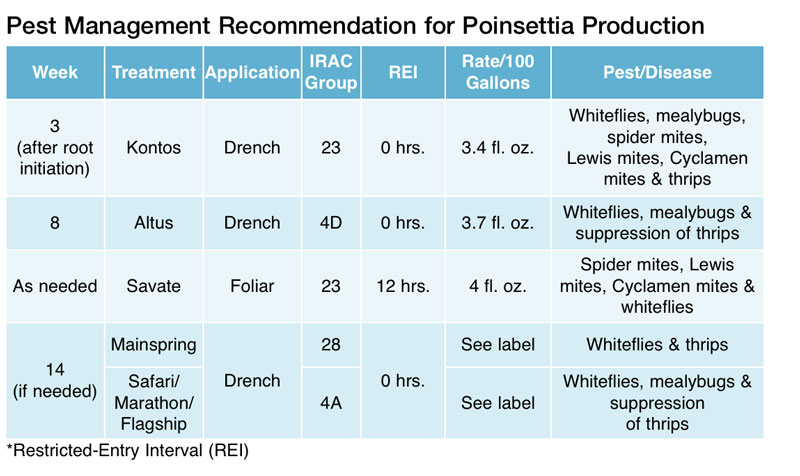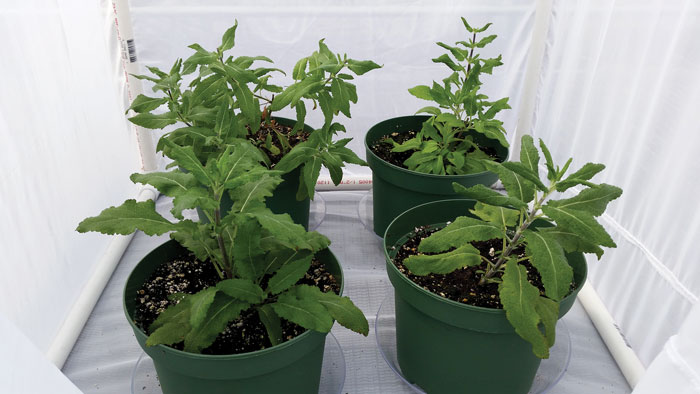7/1/2020
Controlling Common Pests in Poinsettia Production
Dr. Aaron Palmateer

Pest pressure varies by region in greenhouse poinsettias, but the most common insects include whiteflies, mealybugs, mites and thrips. Poinsettias are subject to attack from insect pests and mites all season long, so effective management is a must for quality poinsettia production.
Common pests
Whiteflies continue to be the major insect pest problem for poinsettias. Additionally, growers need to account for whitefly biotypes that have developed over the past decade or have the potential to develop insecticide resistance (i.e., MED whitefly).
Fortunately, Bayer offers three solutions with Altus, Kontos and Savate—all of which are proven effective against MED whitefly. Altus, combined with the predatory mite Amblyseius swirskii or the predatory wasp Eretmocerus eremicus, has shown excellent control of MED whitefly when evaluated by researchers at the University of Florida in collaboration with the USDA.
Poinsettias aren’t a preferred host of thrips, but thrips often migrate from spring bedding plants, garden mums or weeds into poinsettias and shouldn’t be overlooked. Cyclamen mites, Lewis mites and especially spider mites should also be monitored, as they’re all capable of attacking poinsettias. Mealybugs can be a serious issue in warmer and tropical climates. Due to the extremely wet environment in propagation of unrooted cuttings, it also isn’t unusual to be challenged with fungus gnat and shore fly larvae.
 Pictured: Example of non-neonic treatment exposure for MED Whitefly set up in the lab.
Pictured: Example of non-neonic treatment exposure for MED Whitefly set up in the lab.
Regularly scouting for insects is essential and should be used to make decisions about what control strategies should be used and when.
Symptoms
There’s zero tolerance for the presence of whiteflies in today’s poinsettia marketplace. Infestations of whiteflies can be a year-round issue and often their presence (i.e., tiny white flies) can be seen before the damage is observed (i.e., chlorotic leaves with mottling). All stages of whiteflies feed by sucking plant juices from leaves and excreting excess liquid as drops of honeydew. Large colonies typically develop on the undersides of leaves, laying tiny oblong eggs ranging from yellow to white in color. When actively feeding, whiteflies can cause leaves to turn yellow and then brown as the leaf tissue dies.
Thrips are among the most common and difficult insect pests to manage. They primarily attack the youngest leaves and cause distorted growth, resulting in white scarring on the leaves. These symptoms can be mistaken for environmental stress, nutritional deficiencies or fertilizer damage, so it’s important to monitor for thrips activity.
Both adults and larval stages feed on plant tissue with rasping-sucking mouthparts. Most thrips feed on leaf tissue, but some species can be very damaging to young flower buds causing deformation or failure to open. In addition to direct damage, thrips are capable of transmitting plant viruses, making thrips management critical in commercial production settings.

ALWAYS READ AND FOLLOW LABEL INSTRUCTIONS Altus, Kontos and Savate are registered trademarks of Bayer. Nemasys is a registered trademark of BASF. NemaShield is a registered trademark of Bioworks, Inc. Distance, Gnatrol and Safari are registered trademarks of Valent. Azatin is a registered trademark of Certis USA LLC. Citation, Flagship and Mainspring are registered trademarks of Syngenta. Marathon is a registered trademark of OHP, Inc.
 While there are thousands of mite species that cause damage to commercially produced plants, the most common mites in greenhouses and nurseries are spider mites. Mites are the smallest of the pests and feeding damage from mites often causes a bronzing of leaves. Adult mites have eight legs and piercing-sucking mouthparts used to suck fluids from host plants. In addition to direct damage, mites are capable of transmitting plant viruses, making mite management critical in commercial production settings. They feed on the underside of leaves, causing tiny yellow or white speckles on the upper leaf surface. They also produce a fine webbing that can easily be observed.
While there are thousands of mite species that cause damage to commercially produced plants, the most common mites in greenhouses and nurseries are spider mites. Mites are the smallest of the pests and feeding damage from mites often causes a bronzing of leaves. Adult mites have eight legs and piercing-sucking mouthparts used to suck fluids from host plants. In addition to direct damage, mites are capable of transmitting plant viruses, making mite management critical in commercial production settings. They feed on the underside of leaves, causing tiny yellow or white speckles on the upper leaf surface. They also produce a fine webbing that can easily be observed.
Pictured: Various development stages of whiteflies. Photo: Aaron Palmateer, Ph.D.
Adult whiteflies (Bemisia tabaci).Photo: Bayer
Mealybugs can cause poinsettia leaves to turn yellow and plants to subsequently decline in quality. These scale insects come in several forms and are notorious for attacking plants. When not controlled, they can even travel across the country on plant material. Mealybugs feed by inserting mouthparts into plant tissue and sucking out sap. There may be no symptoms when just a few individuals or a small population are present, but larger populations can cause stunting and chlorosis. Leaves may develop yellow spots, branches often die back and sometimes plants completely defoliate.
Fungus gnat larvae can inhibit root development, damaging roots and resulting in stunted growth. Symptoms are similar in appearance to root rot. Fungus gnat larvae can also spread fungal pathogens.
Shore fly larvae don’t damage the plant, but adults can leave black fecal deposits on the plant foliage and spread fungal pathogens.
Pictured: Closeup of treatments for MED whitefly in the lab.

Cultural control
Good sanitation is the start to a healthy crop of poinsettias. Keep floors, walkways and sidewalls of greenhouses free from algae that can serve as a breeding area for fungus gnats and shoreflies. Ensure adequate drainage is in place to avoid standing water, as water management is important to reduce plant stress. Use sticky cards to monitor insect populations and be sure to control weeds to help eliminate alternative plant hosts.
Chemical control
Preventive insecticide applications are practically essential under growing conditions that are required for poinsettia production. Refer to the Bayer recommendation table for an insecticide management program focusing on drench applications. Altus and Kontos can also be safely applied to poinsettias as foliar sprays using rates of 14 fl. oz./100 gal. for Altus and 3.4 fl. oz./100 gal. for Kontos.
If fungus gnat and shorefly larvae are a concern at rooting, growers can consider beneficial nematodes (Steinernema feltiae) such as NemaShield or Nemasys or chemical options such as Gnatrol, Azatin, Citation or Distance. GT
Dr. Aaron Palmateer is a Senior Technical Support Representative, Ornamentals for Bayer.
For more information and tips on how to protect your ornamental crops from pests, contact your Bayer representative or visit www.es.bayer.us/ornamentals.
Resources: Efficacy of foliar application of flupyradifurone on Bemisia tabaci (MED whitefly) and Amblyseius swirskii, 2017; Effect of drench application of flupyradifurone on Bemisia tabaci (MED whitefly) and Amblyseius swirskii, 2017; Efficacy of Eretmocerus eremicus and Flupyradifurone on Bemisia tabaci (MED whitefly), 2017, Vivek Kumar1, Katherine Houben, Cindy L. McKenzie, and Lance S. Osborne
A New Pest ID Tool for Spanish-Speaking Workers
Greenhouses and nurseries are culturally diverse, and English may not be everyone’s first language. While there are bilingual and bicultural staff in place in many nurseries and greenhouses, there are varying levels of literacy among workers and there’s a need to be able to communicate in a more concise way about pests and the solutions to manage them.
That's why Bayer has developed a pest guide specifically for Spanish speakers. This user-friendly guide is easy to follow and includes numerous pictures to help Spanish speakers not only identify pests, but also understand how to leverage Bayer solutions to control those pests.
The pest identification guide will be available to order beginning in July. Visit www.es.bayer.us/spanish-pest-
identification-guide to learn more.